France, a country steeped in history, culture, and natural beauty, is a dream destination for travelers worldwide. From the world's famous attraction, the Eiffel Tower in Paris to the stunning sights of Lavender Fields in Provence, France offers a wealth of iconic tourist attractions and hidden gems waiting to be explored.
Countries bordering France worth visiting are Belgium, Luxembourg, Germany, Switzerland, Italy, Monaco, Andorra, Spain and England. In this article, we will explore 20 popular tourist attractions in France that showcase the best of France's heritage, art, and sights, ensuring an amazing trip for every traveler.
Eiffel Tower
The Eiffel Tower, an iconic symbol of France and the most popular tourist attraction in France stands proudly in the heart of Paris on the Champ de Mars. Completed in 1889 as the entrance arch for the 1889 World's Fair, the tower was initially criticized by some of France's leading artists and intellectuals for its design. However, it has since become a global cultural icon and one of the most recognizable structures in the world.
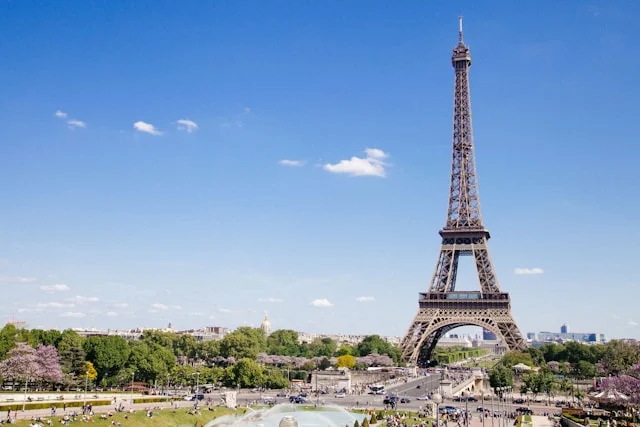
Photo by Anthony DELANOIX
Standing 324 meters (1,063 feet) tall, the Eiffel Tower was the tallest man-made structure in the world until the completion of the Chrysler Building in New York in 1930. It is constructed of wrought iron and comprises 18,038 individual parts held together by 2.5 million rivets. The tower is painted every seven years to protect it from rust.
Visitors can ascend the tower by stairs or elevators to its three platforms, each offering breathtaking views of Paris. The first platform hosts exhibitions, the second has a renowned restaurant (Le Jules Verne), and the third provides panoramic views of the cityscape. Illuminated by thousands of lights at night, the Eiffel Tower remains a testament to human engineering and artistic endeavor, attracting millions of tourists annually.
Louvre Museum
The Louvre Museum, located in Paris, is a French historic monument and the largest art museum in the world. Originally a fortress built in the late 12th century by Philip II, it became a royal palace in the 16th century and was transformed into a public museum during the French Revolution in 1793. The Louvre's vast collection spans over 9,000 years of history and includes works from ancient civilizations to the 19th century.
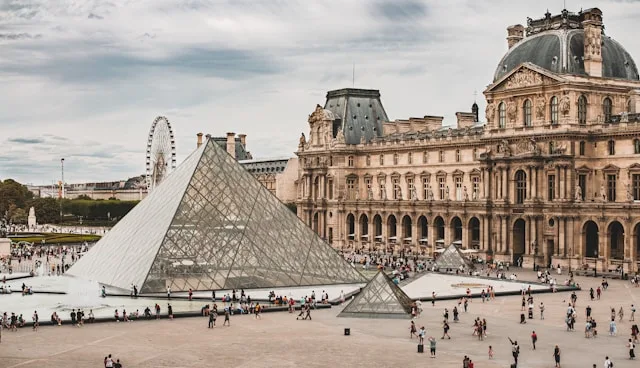
Photo by Mika Baumeister
The museum is home to some of the most famous artworks, including Leonardo da Vinci's "Mona Lisa," the ancient Greek statue "Venus de Milo," and Eugène Delacroix's "Liberty Leading the People." The glass pyramid entrance, designed by architect I. M. Pei completed in 1989, contrasts with the museum's classical architecture, creating a striking visual effect.
Visitors can explore various departments, such as Near Eastern Antiquities, Islamic Art, Sculptures, Decorative Arts, Paintings, and Prints and Drawings. With over 35,000 works on display in an area of 72,735 square meters, the Louvre offers an unparalleled journey through art history, making it a top tourist attraction in Paris for art lovers and history enthusiasts alike.
Château de Versailles
Château de Versailles or Palace of Versailles, located just outside Paris, is a symbol of the absolute monarchy of the Ancien Régime. Originally a hunting lodge built by Louis XIII, it was transformed and expanded by his son Louis XIV in the late 17th century into a magnificent palace that became the center of political power in France until the French Revolution.

Photo by Mathias Reding
Versailles is renowned for its opulent architecture, lavish gardens, and grandiose interiors. The Hall of Mirrors, with its 357 mirrors, crystal chandeliers, and gilded statues, is one of the most famous rooms, where the Treaty of Versailles was signed in 1919, ending World War I. The Royal Apartments, richly decorated, offer a glimpse into the lives of the French monarchy.
The gardens, designed by André Le Nôtre, are an architectural masterpiece, featuring geometrically arranged flower beds, fountains, and sculptures. The Grand Trianon and Petit Trianon, smaller palaces within the estate, provided more intimate spaces for the royals.
Today, the Palace of Versailles is a UNESCO World Heritage site and one of the popular tourist attractions in France, welcoming millions of visitors annually who come to admire its splendor and learn about France's royal history.
Mont Saint-Michel
Mont Saint-Michel, a small rocky island in Normandy, France, is renowned for its stunning medieval abbey and unique tidal phenomenon. The island, located approximately one kilometer off the country's northwestern coast, rises dramatically from the sea, creating a picturesque and mystical scene.
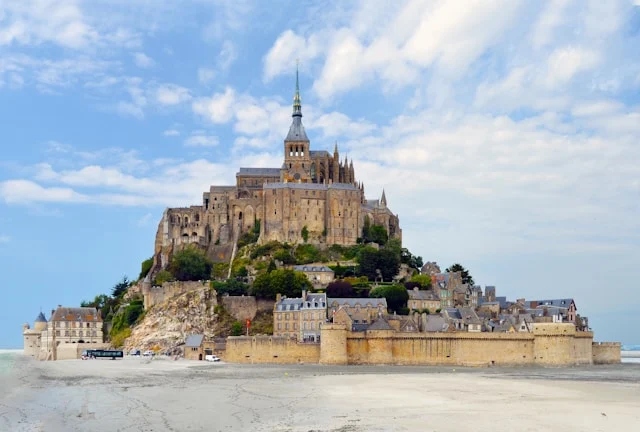
Photo by Gilles DETOT
The island's history dates back to the 8th century when Saint Aubert, the Bishop of Avranches, built an oratory at the request of the Archangel Michael. Over the centuries, it developed into a major pilgrimage site and a formidable fortress. The centerpiece of Mont Saint-Michel is the Benedictine Abbey, an architectural marvel that combines elements of Gothic and Romanesque styles.
Visitors can explore the narrow, winding streets of the village, which are lined with shops, restaurants, and museums. The abbey itself offers breathtaking views of the surrounding bay and showcases intricate stone carvings, cloisters, and chapels. The tidal island is known for its extreme tides, which can vary greatly, making it accessible by foot during low tide and completely surrounded by water at high tide.
Mont Saint-Michel is a UNESCO Heritage site that attracts tourists every year to experience its rich history, spiritual significance, and natural beauty.
Sainte-Chapelle
Sainte-Chapelle, a Gothic-style royal chapel located within the medieval Palais de la Cité in Paris, is renowned for its stunning stained-glass windows. Commissioned by King Louis IX and consecrated in 1248, it was built to house his collection of Passion relics, including the Crown of Thorns, which were later moved to Notre Dame Cathedral.

Source sainte-chapelle.co
The chapel is a masterpiece of Rayonnant Gothic architecture, characterized by its lofty structure, delicate stonework, and extensive use of glass. The lower chapel initially intended for the palace staff, features a richly painted ceiling and walls adorned with biblical scenes. The upper chapel, reserved for the royal family, is a true jewel box of light and color.
Its 15 magnificent stained-glass windows, each 15 meters high, depict over 1,100 biblical scenes from both the Old and New Testaments, creating an awe-inspiring effect when sunlight filters through. The rose window on the western wall is a stunning example of Flamboyant Gothic style, illustrating the Apocalypse.
Sainte-Chapelle is a UNESCO Heritage site and a top tourist attraction, attracting tourists who marvel at its architectural beauty and the ethereal splendor of its stained-glass windows.
Château de Chambord
Château de Chambord, located in the Loire Valley, is one of the most recognizable and impressive châteaux in France. Commissioned by King Francis I in 1519 as a hunting lodge, the château is an architectural masterpiece that combines French medieval forms with classical Renaissance structures.
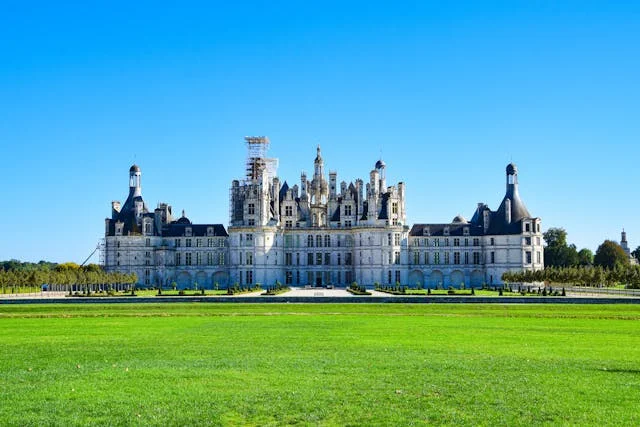
Photo by AXP Photography
The château boasts a distinctive design, with its immense double-helix staircase, believed to be influenced by Leonardo da Vinci, who was a guest of Francis I. The central keep is surrounded by four massive bastion towers and a spectacular array of spires, chimneys, and turrets, giving it a fairy-tale appearance.
With 440 rooms, 282 fireplaces, and 84 staircases, Château de Chambord is the largest château in the Loire Valley. The interior features intricately decorated rooms, vaulted ceilings, and vast halls. The surrounding park and forest, enclosed by a 32-kilometer wall, were originally used for hunting and now offer a tranquil setting for visitors to explore.
The Château de Chambord is a famous UNESCO World Heritage tourist site, attracting visitors captivated by its majestic architecture, historical significance, and the picturesque beauty of the Loire Valley.
Pont du Gard
The Pont du Gard is an ancient Roman aqueduct bridge in the South of France, near Vers-Pont-du-Gard. Built in the first century AD, it is a remarkable feat of Roman engineering and a UNESCO Heritage site.
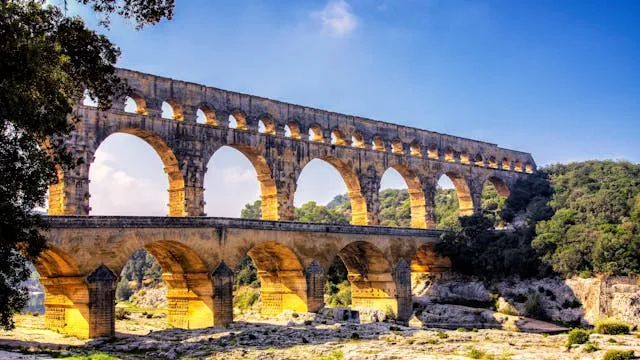
Photo by Carsten Ruthemann
The Pont du Gard is the highest of all Roman aqueduct bridges, standing at 49 meters (160 feet) tall. It spans the Gardon River with a length of 275 meters (902 feet) and is constructed of precisely cut stones, assembled without the use of mortar. The bridge has three tiers of arches, with the largest spanning up to 24.5 meters (80 feet).
Originally part of a 50-kilometer (31-mile) aqueduct system that supplied water to the Roman colony of Nemausus (modern-day Nîmes), the bridge was designed to transport water across the Gardon River valley. The engineering precision and durability of the structure are a testament to the skill of Roman architects and builders.
Today, the Pont du Gard is a major tourist attraction, allowing visitors to explore its ancient structure, enjoy the surrounding natural beauty, and learn about Roman history and engineering through the on-site museum and visitor center.
Père Lachaise Cemetery
Père Lachaise Cemetery, located in the 20th arrondissement of Paris, is the largest cemetery in the city and one of the most famous cemeteries in the world. Opened in 1804, it spans 44 hectares (110 acres) and is the final resting place of many notable figures from various fields, including literature, music, art, and politics.

Photo by Pierre Antona
The cemetery is named after Father François de La Chaise, the confessor to King Louis XIV. It was designed by architect Alexandre-Théodore Brongniart and features winding paths, tree-lined avenues, and an array of elaborate tombs, mausoleums, and sculptures, creating a serene and reflective atmosphere.
Among the most visited graves are playwright Molière, novelist Marcel Proust, rock star Jim Morrison, singer Edith Piaf, and writer Oscar Wilde. The cemetery also contains memorials to victims of various wars and significant historical events.
Père Lachaise is not only a place of burial but also a cultural and historical landmark. It attracts millions of visitors each year who come to pay their respects, explore its artistic and architectural heritage, and enjoy the tranquil beauty of its landscaped grounds.
Arc de Triomphe
The Arc de Triomphe, located at the western end of the Champs-Élysées in Paris, is one of France's famous attractions and monuments. Commissioned by Emperor Napoleon in 1806 after his victory at Austerlitz, the arch was completed in 1836 and stands as a symbol of French national pride and military glory.

Photo by canmandawe
Standing 50 meters (164 feet) tall and 45 meters (148 feet) wide, the Arc de Triomphe is adorned with intricate sculptures and reliefs that commemorate French victories and honor those who fought and died for France during the French Revolutionary and Napoleonic Wars. The four main sculptural groups at the base depict pivotal moments in France's military history.
Beneath the arch lies the Tomb of the Unknown Soldier, added in 1921 to honor the unidentified soldiers who died in World War I. An eternal flame burns in memory of the fallen, and ceremonial events are held here regularly.
Visitors can climb 284 steps to the top of the arch for a panoramic view of Paris, including the twelve avenues radiating from the Place Charles de Gaulle.
Palais des Papes
The Palais des Papes, located in Avignon in southern France, is one of Europe's largest and most important medieval Gothic buildings. Constructed in the 14th century, it served as the residence of the Popes during the Avignon Papacy, when the papal seat was temporarily moved from Rome to Avignon.

Photo by Lottie Griffiths
The palace is a UNESCO World Heritage site and a symbol of the church's influence and power during the Middle Ages. It consists of two main parts: the Old Palace (Palais Vieux), built by Pope Benedict XII, and the New Palace (Palais Neuf), added by Pope Clement VI. The combined structure is a formidable fortress with massive walls, towers, and battlements.
Inside, visitors can explore grand halls, chapels, and private apartments, many of which are adorned with frescoes, tapestries, and other artworks. The Great Chapel and the Consistory Hall are particularly impressive, reflecting the palace's religious and administrative significance.
The Palais des Papes also hosts various cultural events, including the annual Avignon Festival, one of the most important contemporary performing arts festivals in the world and make it a must-visit attraction in France.
Carcassonne Medieval City
Carcassonne is a fortified medieval city in southern France's Languedoc-Roussillon region. Renowned for its well-preserved walls, towers, and castle, it is a UNESCO World Heritage site and one of the iconic examples of medieval architecture in Europe.

Photo by Alain Bonnardeaux
The history of Carcassonne dates back to the Roman era, but its most significant development occurred during the medieval period. The city's double-walled fortifications, stretching nearly 3 kilometers, were primarily constructed in the 12th century by the Trencavel family and later reinforced by King Louis IX and his successors.
Within the walls, visitors can explore the Château Comtal, a 12th-century castle featuring a museum that details the history of Carcassonne and the Cathar heresy. The Basilica of Saints Nazarius and Celsus, with its stunning Gothic and Romanesque architecture, is another highlight.
The narrow, cobbled streets of the medieval city are lined with shops, restaurants, and historic buildings, creating a charming and immersive atmosphere. Carcassonne also offers various activities and events, including medieval-themed festivals and re-enactments.
Carcassonne's rich history, impressive fortifications, and picturesque setting make it France's best destination for history enthusiasts and tourists.
Gorges du Verdon
The Gorges du Verdon, often known as the "Grand Canyon of Europe," is a spectacular river canyon in Provence, southeastern France. Carved by the Verdon River, it stretches approximately 25 kilometers (15 miles) and reaches depths of up to 700 meters (2,300 feet), making it one of the top sights natural sites in Europe.

Photo by Jens Peter Olesen
The Gorges du Verdon is renowned for its stunning turquoise waters, which contrast beautifully with the towering limestone cliffs. The area offers a range of outdoor activities, including hiking, rock climbing, kayaking, and white-water rafting. Popular trails like the Sentier Blanc-Martel provide breathtaking views of the canyon and its diverse flora and fauna.
The region surrounding the Gorges du Verdon is also known for its charming Provençal villages, such as Moustiers-Sainte-Marie and Castellane, where visitors can experience local culture and cuisine. The canyon's scenic beauty and recreational opportunities attract nature lovers and adventure seekers from around the world.
Château de Chenonceau
Château de Chenonceau, located in the Loire Valley, is one of the most elegant and picturesque châteaux in France. Spanning the River Cher, it is often referred to as the "Ladies' Château" due to the influential women who have shaped its history and design.

Photo by Shaun Rainer
The château was originally built in the 16th century by Thomas Bohier and later became the residence of Diane de Poitiers, the mistress of King Henry II, who added the arched bridge that extends over the river. After Henry's death, his widow, Catherine de' Medici, took over the château, enhancing its grandeur and adding the two-story gallery atop the bridge.
Chenonceau's architecture is a harmonious blend of Gothic and Renaissance styles. The interior features richly decorated rooms, including the grand gallery, the bedroom of Louise of Lorraine, and the Green Study, each reflecting the tastes and personalities of its former residents.
The château is surrounded by beautifully landscaped gardens, including the Garden of Diane de Poitiers and the Garden of Catherine de' Medici, as well as a maze, a farm, and an orangery. Visitors can also explore the château's wine cellar, which offers tastings of local wines.
Provence Lavender Fields
The Provence Lavender Fields are one of the most iconic and beautiful natural attractions in Provence, France. Each summer, the rolling hills of Provence are transformed into a sea of vibrant purple as the lavender blooms, creating an aromatic and sensational view that attracts visitors from around the world.

Photo by Baraa Jalahej
The main lavender-growing areas in Provence include the Plateau de Valensole, the Luberon, and the Sault Plateau. The best time to visit and see the lavender in full bloom is from late June to early August, with the peak typically occurring in mid-July.
Visitors to the lavender fields can enjoy a variety of experiences, from leisurely strolls and photography to visiting local distilleries and farms where lavender is harvested and processed into essential oils, soaps, and other products. Many villages in the region, such as Gordes, Roussillon, and Sault, host lavender festivals and markets, offering a chance to taste lavender-infused honey, ice cream, and other delicacies.
The Provence Lavender Fields are not only a visual delight but also offer a sensory experience that captures the essence of rural Provence, making them a must-see for anyone visiting the region.
Château de Fontainebleau
The Château de Fontainebleau, located 55 kilometers southeast of Paris, Fontainebleau is one of the largest and most historically significant royal châteaux in France. It served as a residence for French monarchs from Louis VII to Napoleon III, offering a rich blend of Renaissance and classical architectural styles.

Photo by Eric Prouzet
Originally a medieval hunting lodge, Fontainebleau was transformed and expanded by Francis I in the 16th century. The château's architecture and interiors reflect the tastes of various kings, with highlights including the Francis I Gallery, adorned with Renaissance frescoes and stuccoes, and the grand Ballroom, featuring intricate carvings and paintings.
The château is a UNESCO World Heritage site surrounded by extensive formal gardens, designed by André Le Nôtre, the same landscape architect responsible for the Gardens of Versailles. These include the Grand Parterre, the largest formal garden in Europe, the English Garden, and the Carp Pond.
Inside, visitors can explore over 1,500 rooms, including the opulent apartments of Napoleon Bonaparte, who made Fontainebleau his residence and held significant events there, such as his abdication in 1814.
The Château de Fontainebleau's historical importance, architectural splendor, and beautiful gardens make it a must-visit attraction in France for history and art enthusiasts.
Lascaux Cave Paintings
The Lascaux Cave Paintings, located in the Dordogne region of southwestern France, are among the most famous and well-preserved examples of prehistoric art. Discovered in 1940 by four teenagers, the cave contains over 600 paintings and 1,500 engravings, dating back approximately 17,000 years to the Upper Paleolithic period.

Photo by Toshihiko Tanaka
The artworks depict a variety of animals, including horses, deer, bison, and aurochs, as well as abstract symbols and human figures. The paintings are remarkable for their vivid colors, dynamic compositions, and intricate details, showcasing the skill and creativity of early humans.
Due to concerns about damage from exposure to light and carbon dioxide, the original Lascaux Cave was closed to the public in 1963. To allow continued appreciation of this prehistoric heritage, a replica, Lascaux II, was created nearby, meticulously reproducing the main chambers and their stunning artworks. In 2016, Lascaux IV, an even more comprehensive replica and modern interpretive center, was opened, offering an immersive experience with state-of-the-art displays and interactive exhibits.
The Lascaux Cave Paintings provide a fascinating glimpse into the lives and artistic expression of our prehistoric ancestors, making them a vital cultural and archaeological treasure.
Château de Villandry
The Château de Villandry, located in the Loire Valley, is renowned for its stunning Renaissance gardens, which are considered some of the most beautiful gardens in France. Built in the early 16th century by Jean le Breton, Finance Minister to King Francis I, the château itself is an elegant example of Renaissance architecture.

Photo by AXP Photography
While the château's interiors are charming and historically significant, it is the meticulously designed gardens that truly captivate visitors. The gardens are divided into several distinct areas, each with its unique theme and layout. These include the Ornamental Garden, featuring intricate patterns of clipped boxwood; the Water Garden, with serene pools and fountains; the Herb Garden, filled with medicinal and culinary plants; and the Vegetable Garden, showcasing a colorful array of produce arranged in geometric patterns.
The gardens are maintained with great care, adhering to the principles of organic gardening. Visitors can explore the various terraces, walk along shaded paths, and enjoy panoramic views of the estate and surrounding countryside.
Puy du Fou
Puy du Fou, located in the Vendée region of western France, is a historical theme park that offers a unique and immersive experience through spectacular shows and re-enactments spanning different periods of history. Opened in 1978, it has grown into one of France's popular tourist attractions, attracting millions of visitors every year.

Source achards-tourisme.com
The park features a variety of grand-scale performances, each with elaborate sets, costumes, and special effects. Highlights include "Le Signe du Triomphe," a Roman-style gladiator show set in a full-scale coliseum; "Les Vikings," a dramatic re-enactment of a Viking invasion; and "Le Bal des Oiseaux Fantômes," a breathtaking bird of prey display.
Puy du Fou also offers themed villages that transport visitors to different historical eras, such as a medieval town, a 1900s Belle Époque village, and a Viking settlement. Each village features authentic architecture, craftspeople demonstrating traditional skills, and themed dining options.
The park's signature nighttime show, "La Cinéscénie," involves over 2,000 actors and volunteers, and is a grand spectacle of light, sound, and pyrotechnics that tells the history of the Vendée region.
Paris Catacombs
The Paris Catacombs are an underground ossuary located beneath the streets of Paris, housing the remains of over six million people. Created in the late 18th century to address the city's overflowing cemeteries, the catacombs have become one of Paris's most unique attractions.
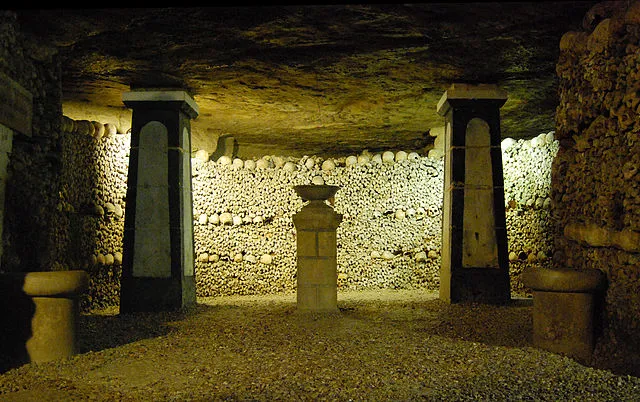
Photo by Albany Tim
The catacombs are part of a vast network of former limestone quarries that were repurposed to store bones transferred from cemeteries like the Saints-Innocents, which posed health risks due to overcrowding. The transfer of bones began in 1786 and continued into the 19th century.
Visitors enter the catacombs through a small building in the 14th arrondissement and descend a spiral staircase into a labyrinth of dark, narrow tunnels lined with carefully arranged bones and skulls. The ossuary features various inscriptions and decorations, adding to its eerie yet fascinating atmosphere.
The catacombs span approximately 1.7 kilometers (1.1 miles) of accessible passageways, offering a glimpse into Paris's subterranean history and the city's past burial practices. Guided tours provide historical context and insights into the catacombs' creation and significance.
Pont Alexandre III
Pont Alexandre III, widely regarded as the most ornate and elegant bridge in Paris, spans the River Seine, connecting the Champs-Élysées quarter with the Invalides and Eiffel Tower district. Completed in 1900 for the Exposition Universelle (World's Fair), the bridge was named in honor of Tsar Alexander III of Russia, symbolizing the Franco-Russian alliance.

Photo by Léonard Cotte
The bridge is a masterpiece of Beaux-Arts architecture and design, featuring lavish decorations, including Art Nouveau-style lamps, cherubs, nymphs, and winged horses. The four gilded statues on massive pillars at each end of the bridge represent various allegorical figures, such as Fame of the Arts and Fame of Sciences.
Pont Alexandre III is not only a functional crossing but also a work of art that offers stunning sights of the Seine and some of Paris's most iconic landmarks, including the Eiffel Tower, Les Invalides, and the Grand Palais. Its aesthetic appeal and historical significance make it a favorite spot for locals and tourists, as well as a popular location for photography and film shoots.
Walking across Pont Alexandre III provides a romantic and picturesque experience, capturing the essence of Parisian elegance and architectural grandeur.
France's rich cultural buildings, diverse sightseeing, and world-class attractions make it a top destination for travelers seeking history, art, and natural beauty. Whether exploring the iconic landmarks of Paris, the Eiffel Tower, wandering through the picturesque Mont Saint-Michel, or marveling at the opulence of Pont du Gard, visitors to France are guaranteed an amazing trip filled with experiences. So book a flight now, enjoy the beauty of France, and embark on a journey to popular tourist attractions in France that will leave you with unforgettable memories that will last a lifetime.